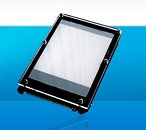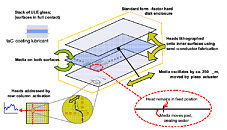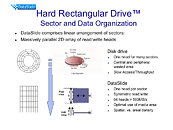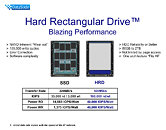Friday, June 26th 2009
Hard Rectangular Drive Could be the Hard Disk Answer to SSDs
A company called DataSlide has decided its not time for mechanical disk drives also known as hard disk drives (HDD) to roll over and die with SSDs beating them in just about every aspect other than price. The key aspect of the new technology is that it does not require the data platter to be spun like conventional hard disk drives do. For a start this provides savings in power consumption and due to the use of magnetic recording media as found in hard disk drives should allow the hard rectanguar drive (HRD) to be cheaper than an SSD or at least provide significantly more usable space for your money. A diagram explaining the technology and the manufacturers details and specifications follow.DataSlide's Hard Rectangular Drive (HRD) capitalizes on standard base process technologies to create a dramatically new way to store and retrieve data with magnetic media:
1. Leverage LCD process
2. Use standard HDD sputtering/plating MEMS process
3. Use HDD perpendicular media DSSC/Oerlikon-Balzers coatings
DataSlide applies technology in new, patented ways to achieve unprecedented high performance
160,000 IOPS & 500MB/sec and low power <4 Watts for a magnetic storage device:
1. A piezoelectric actuator keeps the rectangular media in precise motion
2. A diamond solid lubricant coating protects the surfaces for years of worry free service
3. A massively parallel 2D array of magnetic heads reads from or writes to up to 64 embedded heads at a time
Source:
DataSlide
1. Leverage LCD process
2. Use standard HDD sputtering/plating MEMS process
3. Use HDD perpendicular media DSSC/Oerlikon-Balzers coatings
DataSlide applies technology in new, patented ways to achieve unprecedented high performance
160,000 IOPS & 500MB/sec and low power <4 Watts for a magnetic storage device:
1. A piezoelectric actuator keeps the rectangular media in precise motion
2. A diamond solid lubricant coating protects the surfaces for years of worry free service
3. A massively parallel 2D array of magnetic heads reads from or writes to up to 64 embedded heads at a time




70 Comments on Hard Rectangular Drive Could be the Hard Disk Answer to SSDs
This isnt reinventing the wheel, this is using caterpillar legs instead.
These will be a data recovery experts worst nightmare I bet, I do hope these are as promising as the pictures state, high speed, cheap, large storage, my god, if it were true you would just buy like six and raid 0 +1 them together and never have to worry about speed/performance or capacity for a very long time.
It would be great to see it out soon as the more competition (faster speeds/density) the better the pricing should be.
It does have drawbacks of course: It's expensive to make, and it generally requires high temperatures to deposit which is often bad for what you to put it on and can cause high stress in the material at room temperature.
I could be mistaken, but isn't there a diamond based TIM on the market?
SSD is just a huge SD card lol maybe not exactly the same but same principles
i want programs to load faster and load times in programs reduced
someone explain how it works is it like hundreds of heads reading or something?
get enough of em together, and you can read massive amounts of data simultaneously.
seriously, i could be totally tripping on this. its rather late/early in the morning here.